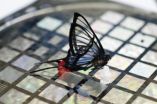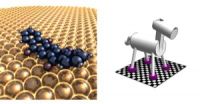(Press-News.org) Beyond the orbit of Neptune reside countless icy rocks known as trans-Neptunian objects (TNOs). One of the biggest, Pluto, is classified as a dwarf planet. The region also supplies us with comets such as famous Comet Halley. Most TNOs are small and receive little sunlight, making them faint and difficult to spot.
Now, astronomers using clever techniques to cull the data archives of NASA's Hubble Space Telescope have added 14 new TNOs to the catalog. Their method promises to turn up hundreds more.
"Trans-Neptunian objects interest us because they are building blocks left over from the formation of the solar system," explained lead author Cesar Fuentes, formerly with the Harvard-Smithsonian Center for Astrophysics and now at Northern Arizona University.
As TNOs slowly orbit the sun, they move against the starry background, appearing as streaks of light in time exposure photographs. The team developed software to analyze hundreds of Hubble images hunting for such streaks. After promising candidates were flagged, the images were visually examined to confirm or refute each discovery.
Most TNOs are located near the ecliptic -- a line in the sky marking the plane of the solar system (since the solar system formed from a disk of material). Therefore, the team searched within 5 degrees of the ecliptic to increase their chance of success.
They found 14 objects, including one binary (two TNOs orbiting each other like a miniature Pluto-Charon system). All were very faint, with most measuring magnitude 25-27 (more than 100 million times fainter than objects visible to the unaided eye).
By measuring their motion across the sky, astronomers calculated an orbit and distance for each object. Combining the distance and brightness (plus an assumed albedo or reflectivity), they then estimated the size. The newfound TNOs range from 25 to 60 miles (40-100 km) across.
Unlike planets, which tend to have very flat orbits (known as low inclination), some TNOs have orbits significantly tilted from the ecliptic (high inclination). The team examined the size distribution of TNOs with low- versus high-inclination orbits to gain clues about how the population has evolved over the past 4.5 billion years.
Generally, smaller trans-Neptunian objects are the shattered remains of bigger TNOs. Over billions of years, these objects smack together, grinding each other down. The team found that the size distribution of TNOs with low- versus high-inclination orbits is about the same as objects get fainter and smaller. Therefore, both populations (low and high inclination) have similar collisional histories.
This initial study examined only one-third of a square degree of the sky, meaning that there is much more area to survey. Hundreds of additional TNOs may lurk in the Hubble archives at higher ecliptic latitudes. Fuentes and his colleagues intend to continue their search.
"We have proven our ability to detect and characterize TNOs even with data intended for completely different purposes," Fuentes said.
INFORMATION:
This research has been accepted for publication in The Astrophysical Journal and is available online.
NASA's Hubble harvests distant solar system objects
2010-09-13
ELSE PRESS RELEASES FROM THIS DATE:
Few white voters upset about Obama victory despite lingering racism
2010-09-13
GAINESVILLE, Fla. --- Racism may be less of a factor in politics than other realms of life, according to a new University of Florida study, which found few white voters in Florida to be upset by the presidential candidacy of a black man, and many to be proud of it.
To assess attitudes among white voters in a southern state about Barack Obama's historic election to the presidency, two UF political scientists analyzed results from four statewide telephone surveys -- each involving between 449 and 829 respondents – conducted in the fall of 2008 and spring of 2009. Their ...
If the water looks and smells bad, it may be toxic
2010-09-13
Earthy or musty odors, along with visual evidence of blue-green algae, also known as cyanobacteria, may serve as a warning that harmful cyanotoxins are present in lakes or reservoirs. In a newly published USGS study of cyanobacterial blooms in Midwest lakes, taste-and-odor compounds were found almost every time cyanotoxins were found, indicating odor may serve as a warning that harmful toxins are present.
"It is commonly believed that there are no health risks associated with taste-and-odor compounds," said Dr. Jennifer Graham, USGS limnologist and lead scientist on this ...
Avoiding an asteroid collision
2010-09-13
Though it was once believed that all asteroids are giant pieces of solid rock, later hypotheses have it that some are actually a collection of small gravel-sized rocks, held together by gravity. If one of these "rubble piles" spins fast enough, it's speculated that pieces could separate from it through centrifugal force and form a second collection ― in effect, a second asteroid.
Now researchers at Tel Aviv University, in collaboration with an international group of scientists, have proved the existence of these theoretical "separated asteroid" pairs.
Ph.D. student ...
Male maturity shaped by early nutrition
2010-09-13
EVANSTON, Ill. --- It seems the old nature versus nurture debate can't be won. But a new Northwestern University study of men in the Philippines makes a strong case for nurture's role in male to female differences -- suggesting that rapid weight gain in the first six months of life predicts earlier puberty for boys.
Males who experienced rapid growth as babies -- an indication that they were not nutritionally stressed -- also were taller, had more muscle and were stronger, and had higher testosterone levels as young adults. They had sex for the first time at a younger ...
Manatee subspecies genetically confirmed, but diversity challenge looms
2010-09-13
Gainesville, FL. -- The first genetic study to compare nuclear DNA of endangered Antillean manatees in Belize with Florida manatees confirmed their designation as separate subspecies. Belize's manatees, however, were found to have extremely low genetic diversity, raising questions about their long-term genetic viability.
The Central American country of Belize hosts the largest known breeding population of Antillean manatees and is touted by biologists for its potential to repopulate other parts of Central America where manatees are severely reduced, rare or absent.
...
Information patients use to pick physicians not always good predictor of quality, study finds
2010-09-13
When looking for a new physician, patients are often encouraged to select those who are board certified or who have not made payments on malpractice claims. Yet these characteristics are not always a good predictor of which physicians will provide the highest quality medical care, according to a new study from the RAND Corporation, a nonprofit research organization, and the University of Pittsburgh School of Medicine.
"We found that the types of information widely available to patients for choosing a physician do not predict whether that physician will deliver evidence-based ...
Wildflower 'armors' itself against disease
2010-09-13
An unusual wildflower that accumulates metals in its leaves has been found to use them as a kind of 'armor' against bacterial infection. Scientists from Oxford University have shown that when Alpine pennycress (Thlaspi caerulescens) plants accumulate metals in their leaves, they become resistant to attack by the bacterium Pseudomonas syringae pv. maculicola. They report their findings September 9 in the open-access journal PLoS Pathogens.
Thlaspi, a small plant in the mustard family that grows on metal-rich soils scattered around Britain and Europe, such as the sites ...
New artificial skin could make prosthetic limbs and robots more sensitive
2010-09-13
VIDEO:
Artificial skin for people and robots could be a reality using the ultra-sensitive sensors developed by Zhenan Bao, associate professor of chemical engineering at Stanford University, and her team. The...
Click here for more information.
The light, tickling tread of a pesky fly landing on your face may strike most of us as one of the most aggravating of life's small annoyances. But for scientists working to develop pressure sensors for artificial skin for use on ...
Would a molecular horse trot, pace or glide across a surface?
2010-09-13
RIVERSIDE, Calif. – Molecular machines can be found everywhere in nature, for example, transporting proteins through cells and aiding metabolism. To develop artificial molecular machines, scientists need to understand the rules that govern mechanics at the molecular or nanometer scale (a nanometer is a billionth of a meter).
To address this challenge, a research team at the University of California, Riverside studied a class of molecular machines that 'walk' across a flat metal surface. They considered both bipedal machines that walk on two 'legs' and quadrupedal ones ...
New pathway identified in Parkinson's through brain imaging
2010-09-13
(NEW YORK, NY, September 13, 2010) – A new study led by researchers at Columbia University Medical Center has identified a novel molecular pathway underlying Parkinson's disease and points to existing drugs which may be able to slow progression of the disease.
The pathway involved proteins – known as polyamines – that were found to be responsible for the increase in build-up of other toxic proteins in neurons, which causes the neurons to malfunction and, eventually, die. Though high levels of polyamines have been found previously in patients with Parkinson's, the new ...



